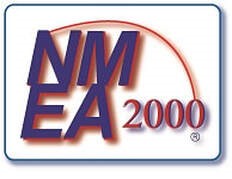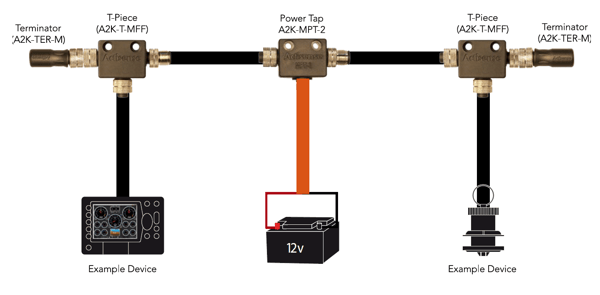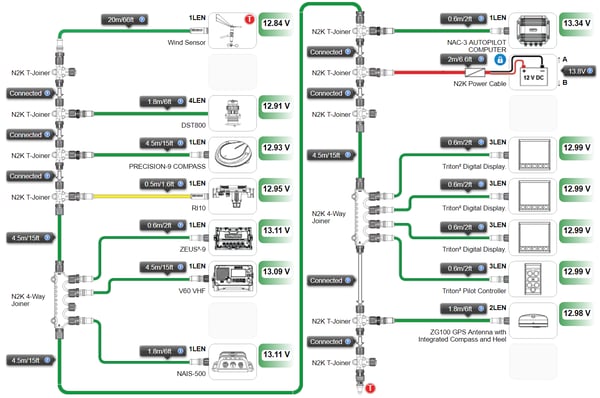 Image credit: Navico
Image credit: Navico
Anyone who has so much as dabbled in marine electronics will have come across the term NMEA, often colloquially expressed as “NEMA”.
This is the acronym for the National Marine Electronics Association, a non-profit organisation based in the US who manage communication protocols and standards for marine electronics and promote compatibility across manufacturers. This blog aims to give a brief overview of the NMEA 2000 protocol and the basic features of a NMEA 2000 network.
What is NMEA?
There are currently 3 different interface standards owned and managed by NMEA: NMEA 0183, NMEA 2000 and NMEA OneNet. By far the most widely used today is the NMEA 2000 protocol which superseded its 0183 predecessor, offering simpler connectivity and higher data rates.
N2K

NMEA 2000 (often referred to as N2K) is based on the Controller Area Network (CAN) system, borrowed from the automotive industry. This network consists of a single cable onto which multiple devices can be connected. While Ethernet based systems like OneNet offer far greater bandwidth, N2K is still the most robust and reliable for transferring safety-critical navigation data in real time. In addition, a certification process exists for NMEA 2000 devices meaning that any product which bears the logo has been certified as NMEA 2000 compatible.
Terminology
In addition to the terms we have already mentioned like N2K, “NEMA” and CAN, here are some of the most common phrases used in relation to NMEA 2000:
- Backbone: this refers to the single trunk cable which runs through the boat and onto which devices are connected using T-pieces. Depending on the type of cable, N2K can support a maximum system length of 100-250m.
- Drop cable: The shorter lengths of cable which connect each device onto the backbone via a T-connector. Drop cables can be a maximum of 6m but should be kept as short as possible. Combined drop cable length should not exceed 78m.
Advantages of NMEA 2000
- Simple and low cost: All devices are allowed to communicate with each other through a single backbone which also features an integrated power supply, thus minimising installation cost and complexity.
- Larger networks: NMEA 2000 networks support up to 50 devices on a single backbone.
- Faster: The NMEA 2000 transmission rate is 250kbps compared to a maximum of 38.4kbps of a highspeed NMEA 0183 system.
- Reliable and robust: The CAN based system is less susceptible to noise and interference than a serial protocol like NMEA 0183 and allows devices to be removed or added without restarting the network.
- Compatibility: As the most widely used protocol, NMEA 2000 allows devices from different manufacturers to communicate on the same network. Additionally, NMEA 0183 devices can be integrated using low-cost gateways.
NMEA 2000 network layout
At the core of any NMEA 2000 network are the following components:
- Backbone cable
- Power insertion point
- At least 2 NMEA 2000 certified devices, plus connectors
- 2 terminators. These are important!

Image credit: Actisense
Further devices can be integrated to the network anywhere along the backbone simply by adding additional T-connectors. It can also be worth adding unused T-connectors at the ends of the backbone for diagnostic purposes.
The following image shows a more complex NMEA 2000 network from the Navico System Builder:

Image credit: Navico
To summarise
The National Marine Electronics Association owns and manages the standardised NMEA protocols which promote compatibility of marine electronics devices across multiple manufacturers.
NMEA 2000 is the bigger, better, faster, stronger cousin to NMEA 0183. While Ethernet based systems offer greater bandwidth for increasingly data heavy network requirements, NMEA 2000 remains the number one choice for critical navigation data. NMEA 2000 protocol is used by the majority of marine electronics manufacturers allowing simple integration between devices and is also backwards compatible with NMEA 0183.
A NMEA 2000 network is simple, reliable and extremely flexible.
If you have any questions please feel free to email us at support@upffront.com, or click the link below to see our full range:




